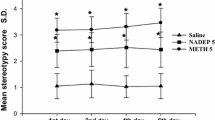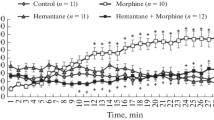Summary
The interactions of morphine with the agonist at dopamine receptors apomorphine were studied on the behavioural and biochemical level. Apomorphine (0.5 mg/kg s.c.) produced stereotyped sniffing and some licking behaviour. Pretreatment with morphine enhanced licking behaviour and, in addition, produced some gnawing behaviour, a sign which is seen after a larger dose of apomorphine alone as well. This enhancement by morphine was maximal after 3.3 mg/kg i.p. and less pronounced after smaller or larger doses of morphine; naloxone (1 mg/kg i.p.) antagonized the enhancement. Morphine did not affect the decrease in the concentration of 3,4-dihydroxyphenylacetic acid (DOPAC) produced by apomorphine in striatum and nucleus accumbens. In contrast, morphine increased the concentration of 3-methoxytyramine (3-MT) in both areas after pretreatment with pargyline (75 mg/kg i.p.), suggesting that it increased the release of dopamine, which might explain the enhancement of apomorphine-induced stereotyped behaviour.
The enhancement by morphine of stereotyped behaviour produced by lisuride (2 or 4 mg/kg i.p.), another agonist at dopamine receptors, was much less pronounced than on apomorphine-induced stereotypies.
Similar content being viewed by others
References
Balsara JJ, Nandal NV, Burte NP, Jadhav JH, Chandokar AG (1984) Effects of naloxone on methamphetamine and apomorphine stereotypy and on haloperidol catalepsy in rats. Psychopharmacol 82:237–240
Beart PM (1982) Multiple dopamine receptors — new vistas. In: Lamble JW (ed) More about receptors. Current reviews in biomedicine. Elsevier Biomedical Press, Amsterdam, pp 87–92
Broderick PA (1985) In vivo electrochemical studies of rat striatal dopamine and serotonin release after morphine. Life Sci 36:2269–2276
Cabib S, Puglisi-Allegra S, Oliverio A (1984) Chronic stress enhances apomorphine-induced stereotyped behavior in mice: involvement of endogenous opioids. Brain Res 298:138–140
Carlson KR (1977) Narcotic mechanisms and dyskinesias. In: Hanin I, Usdin E (eds) Animal models in psychiatry and neurology. Pergamon Press, New York, pp 391–402
Carlsson A (1975) Receptor-mediated control of dopamine metabolism. In: Usdin E, Bunney WE Jr (eds) Pre-and postsynaptic receptors, Marcel Dekker Inc., New York, pp 49–63
Costall B, Naylor RJ (1973) The role of telencephalic dopaminergic systems in the mediation of apomophine-stereotyped behaviour. Eur J Pharmacol 24:8–24
Feigenbaum J, Yanai J, Moon B, Klawans H (1983) Effect of naloxone and morphine on dopamine agonist-induced stereotypy in rats and guinea pigs. Neuropharmacol 22:1369–1376
Fleminger S, Rupniak NMJ, Hall MD, Jenner P, Marsden CD (1983) Changes in apomorphine-induced stereotypy as a result of subacute neuroleptic treatment correlates with increased D-2 receptors, but not with increase in D-1 receptors. Biochem Pharmacol 32:2921–2927
Genç E, Havemann U, Tzoneva-Tyutyulkova N, Kuschinsky K (1983) Motility, rigidity and turnover of dopamine in the striatum after administration of morphine to rats: a re-evaluation of their mechanism. Neuropharmacology 22:471–476
Havemann U, Kuschinsky K (1982) Neurochemical aspects of the opioid-induced “catatonia”. Neurochem Intern 4:199–215
Havemann U, Magnus B (1985) Contrasting effects of morphine on apomorphine-induced stereotypies and motility patterns of rats — an open field study. Naunyn-Schmiedeberg's Arch Pharmacol 329 Suppl: R 84
Havemann U, Magnus B, Möller HG, Kuschinsky K (1986) Individual and morphological differences in the behavioural response to apomorphine in rats. Psychopharmacology 90:40–48
Kehr W (1976) 3-Methoxytyramine as an indicator of impulse-induced dopamine release in rat brain in vivo. Naunyn-Schmiedeberg's Arch Pharmacol 293:209–215
Kehr W (1977) Effect of lisuride and other ergot derivatives on monoaminergic mechanisms in rat brain. Eur J Pharmacol 41:261–273
Kelly PH, Seviour PW, Iversen SD (1975) Amphetamine and apomorphine responses in the rat following 6-OHDA lesions of the nucleus accumbens septi and corpus striatum. Brain Res 94:507–522
Martin JR, Takemori AE (1985) Increased sensitivity to dopamine agonists following a single dose of morphine or levorphanol in mice. Eur J Pharmacol 119:75–84
McKenzie GM, Sadof MJ (1974) Effects of morphine and chlorpromazine on apomorphine-induced stereotyped behaviour. J Pharm Pharmacol 26:280–282
Melzacka M, Neßelhut T, Havemann U, Vetulani J, Kuschinski K (1985) Pharmacokinetics of morphine in striatum and nucleus accumbens: relationship to pharmacological actions. Pharmacol Biochem Behaviour 23:295–301
Molloy AG, Waddington JL (1984) Dopaminergic behaviour stereospecifically promoted by the D1 agonist R-SK & F 38393 and selectively blocked by the D1 antagonist SCH 23390. Psychopharmacology 82:409–410
Scheel-Krüger J, Golembiowska K, Mogilnicka E (1977) Evidence for increased apomorphine-sensitive dopaminergic effects after acute treatment with morphine. Psychopharmacology 53:55–63
Spampinato U, Invernizzi R, Nowakowska E, Samanin R (1984) Reduction of morphine's effect on striatal dopamine metabolism in rats treated with a low dose of apomorphine or agents increasing serotonin transmission. Biochem Pharmacol 33: 163–165
Waldmeier PC, Lauber J, Blum W, Richter WJ (1981) 3-Methoxytyramine — its suitability as an indicator of synaptic dopamine release. Naunyn-Schmiedeberg's Arch Pharmacol 315:219–225
Westerink BHC (1985) Sequence and significance of dopamine metabolism in the rat brain. Neurochem Internat 7:221–227
Westerink BHC, Korf J (1976) Turnover of acid dopamine metabolites in striatal and mesolimbic tissue of the rat brain. Eur J Pharmacol 37:249–255
Author information
Authors and Affiliations
Rights and permissions
About this article
Cite this article
Möller, H.G., Kuschinsky, K. Interactions of morphine with apomorphine: behavioural and biochemical studies. Naunyn-Schmiedeberg's Arch. Pharmacol. 334, 452–457 (1986). https://doi.org/10.1007/BF00569385
Received:
Accepted:
Issue Date:
DOI: https://doi.org/10.1007/BF00569385




